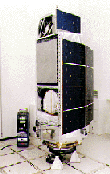|
|

HEAO-3
HEAO-3, like HEAO-1, was a survey mission involving several independent but
complementary instruments. This satellite was launched by NASA on September 20,
1979 into an orbit of 500 km altitude, 43.6 degrees inclination. The mission
included two cosmic ray experiments, the Heavy Nuclei Experiment, the Cosmic
Ray Isotope Experiment, and the Gamma-Ray Spectroscopy Experiment.
The Gamma Ray Spectroscopy Experiment on HEAO-3 consisted of four p-type,
high purity germanium detectors, each with a volume of ~100 cm3.
The detectors were surrounded by a large CsI shield in electronic
anti-coincidence, which was segmented in order to provide crude directionality.
These detectors had an energy range of 50 keV-10 MeV. An initial energy
resolution of 3 keV at 1.46 MeV was achieved for each detector. The instrument
had a 30 degree (FWHM) field of view and, under favorable background
conditions, could independently detect bursts with fluences as low as 2 x 10
-6 ergs/cm2 above the lower energy limit. For unfavorable
background conditions, the lower limit might be 5-10 times higher than this.
During the planned 6 month mission, the high resolution gamma-ray
spectrometer on-board performed an all-sky survey for narrow cosmic gamma-ray
line emission to a sensitivity of about 10-4 photons/cm2
/s over an operating energy range of 0.05-10 MeV. Analyses of the HEAO-3
on-orbit background (Wheaton et al. 1987) also found ~130 detectable gamma-ray
lines.
[HEAO-3 Home]
[About HEAO-3]
[Archive]
[Gallery]
[Publications]
Page authors: Lorella Angelini Jesse Allen
HEASARC Home |
Observatories |
Archive |
Calibration |
Software |
Tools |
Students/Teachers/Public
Last modified: Wednesday, 08-Oct-2003 18:52:27 EDT
|


